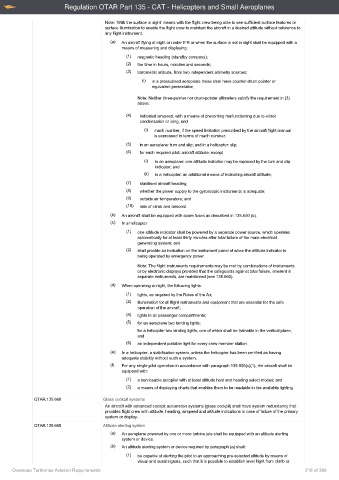Page 218 - Overseas Territories Aviation Requirements Consolidated - Total AOC
P. 218
Regulation OTAR Part 135 - CAT - Helicopters and Small Aeroplanes
Note: ‘With the surface in sight’ means with the flight crew being able to see sufficient surface features or
surface illumination to enable the flight crew to maintain the aircraft in a desired attitude without reference to
any flight instrument.
(a) An aircraft flying at night or under IFR or when the surface is not in sight shall be equipped with a
means of measuring and displaying:
(1) magnetic heading (standby compass);
(2) the time in hours, minutes and seconds;
(3) barometric altitude, from two independent altimetry sources;
(i) in a pressurised aeroplane these shall have counter-drum pointer or
equivalent presentaton;
Note: Neither three-pointer nor drum-pointer altimeters satisfy the requirement in (3)
above.
(4) indicated airspeed, with a means of preventing malfunctioning due to either
condensation or icing; and
(i) mach number, if the speed limitation prescribed by the aircraft flight manual
is expressed in terms of mach number;
(5) in an aeroplane: turn and slip; and in a helicopter: slip;
(6) for each required pilot: aircraft attitude; except
(i) in an aeroplane: one attitude indicator may be replaced by the turn and slip
indicator; and
(ii) in a helicopter: an additional means of indicating aircraft attitude;
(7) stabilised aircraft heading;
(8) whether the power supply to the gyroscopic instruments is adequate;
(9) outside air temperature; and
(10) rate of climb and descent.
(b) An aircraft shall be equipped with spare fuses as described in 135.640 (b).
(c) In a helicopter:
(1) one attitude indicator shall be powered by a separate power source, which operates
automatically for at least thirty minutes after total failure of the main electrical
generating system; and
(2) shall provide an indication on the instrument panel of when the attitude indicator is
being operated by emergency power.
Note: The flight instruments requirements may be met by combinations of instruments
or by electronic displays provided that the safeguards against total failure, inherent in
separate instruments, are maintained (see 135.660).
(d) When operating at night, the following lights:
(1) lights, as required by the Rules of the Air;
(2) illumination for all flight instruments and equipment that are essential for the safe
operation of the aircraft;
(4) lights in all passenger compartments;
(5) for an aeroplane two landing lights;
for a helicopter two landing lights, one of which shall be trainable in the vertical plane;
and
(6) an independent portable light for every crew member station.
(e) In a helicopter, a stabilisation system, unless the helicopter has been certified as having
adequate stability without such a system.
(f) For any single pilot operation in accordance with paragraph 135.905(c)(1), the aircraft shall be
equipped with:
(1) a serviceable autopilot with at least altitude hold and heading select modes; and
(2) a means of displaying charts that enables them to be readable in the available lighting.
OTAR.135.660 Glass cockpit systems
An aircraft with advanced cockpit automation systems (glass cockpit) shall have system redundancy that
provides flight crew with attitude, heading, airspeed and altitude indications in case of failure of the primary
system or display.
OTAR.135.665 Altitude alerting system
(a) An aeroplane powered by one or more turbine jets shall be equipped with an altitude alerting
system or device.
(b) An altitude alerting system or device required by paragraph (a) shall:
(1) be capable of alerting the pilot to an approaching pre-selected altitude by means of
visual and aural signals, such that it is possible to establish level flight from climb or
Overseas Territories Aviation Requirements 218 of 386

